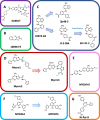Taking the Myc out of cancer: toward therapeutic strategies to directly inhibit c-Myc
- PMID: 33397405
- PMCID: PMC7780693
- DOI: 10.1186/s12943-020-01291-6
Taking the Myc out of cancer: toward therapeutic strategies to directly inhibit c-Myc
Abstract
c-Myc is a transcription factor that is constitutively and aberrantly expressed in over 70% of human cancers. Its direct inhibition has been shown to trigger rapid tumor regression in mice with only mild and fully reversible side effects, suggesting this to be a viable therapeutic strategy. Here we reassess the challenges of directly targeting c-Myc, evaluate lessons learned from current inhibitors, and explore how future strategies such as miniaturisation of Omomyc and targeting E-box binding could facilitate translation of c-Myc inhibitors into the clinic.
Keywords: Leucine zipper; Oncogene; Peptide; Protein-protein interaction; Transcription.
Conflict of interest statement
JMM is an advisor to Sapience Therapeutics. The authors declare no other competing interests.
Figures




Similar articles
-
Intrinsic cell-penetrating activity propels Omomyc from proof of concept to viable anti-MYC therapy.Sci Transl Med. 2019 Mar 20;11(484):eaar5012. doi: 10.1126/scitranslmed.aar5012. Sci Transl Med. 2019. PMID: 30894502 Free PMC article.
-
Targeting of the MYCN protein with small molecule c-MYC inhibitors.PLoS One. 2014 May 23;9(5):e97285. doi: 10.1371/journal.pone.0097285. eCollection 2014. PLoS One. 2014. PMID: 24859015 Free PMC article.
-
Omomyc Reveals New Mechanisms To Inhibit the MYC Oncogene.Mol Cell Biol. 2019 Oct 28;39(22):e00248-19. doi: 10.1128/MCB.00248-19. Print 2019 Nov 15. Mol Cell Biol. 2019. PMID: 31501275 Free PMC article.
-
MYC as a target for cancer treatment.Cancer Treat Rev. 2021 Mar;94:102154. doi: 10.1016/j.ctrv.2021.102154. Epub 2021 Jan 19. Cancer Treat Rev. 2021. PMID: 33524794 Review.
-
Targeting MYC with protein drugs.Prog Mol Biol Transl Sci. 2025;212:1-23. doi: 10.1016/bs.pmbts.2024.07.001. Epub 2024 Jul 19. Prog Mol Biol Transl Sci. 2025. PMID: 40122642 Review.
Cited by
-
Inhibitory Effect of Lactobacillus Paracasei CMU-Pb-L5 In a Subcutaneous Transplanted Tumor Model of Colorectal Cancer.Int J Med Sci. 2024 Sep 30;21(13):2525-2536. doi: 10.7150/ijms.99646. eCollection 2024. Int J Med Sci. 2024. PMID: 39439459 Free PMC article.
-
Integration of signaling pathway and bromodomain and extra-terminal domain inhibition for the treatment of mutant Kirsten rat sarcoma viral oncogene homolog cancer.Explor Target Antitumor Ther. 2023;4(5):1027-1038. doi: 10.37349/etat.2023.00178. Epub 2023 Oct 26. Explor Target Antitumor Ther. 2023. PMID: 38023987 Free PMC article. Review.
-
Aggressive Gliomatosis Peritonei Arising from Ovarian Mature Teratoma with NF1 Mutation: A Case Report and Literature Review.Cancer Manag Res. 2022 Oct 12;14:2979-2986. doi: 10.2147/CMAR.S374987. eCollection 2022. Cancer Manag Res. 2022. PMID: 36247331 Free PMC article.
-
The insulin and IGF signaling pathway sustains breast cancer stem cells by IRS2/PI3K-mediated regulation of MYC.Cell Rep. 2022 Dec 6;41(10):111759. doi: 10.1016/j.celrep.2022.111759. Cell Rep. 2022. PMID: 36476848 Free PMC article.
-
SR Splicing Factors Promote Cancer via Multiple Regulatory Mechanisms.Genes (Basel). 2022 Sep 16;13(9):1659. doi: 10.3390/genes13091659. Genes (Basel). 2022. PMID: 36140826 Free PMC article. Review.
References
Publication types
MeSH terms
Substances
Grants and funding
- BB/T018275/1/BB_/Biotechnology and Biological Sciences Research Council/United Kingdom
- A26941/CRUK_/Cancer Research UK/United Kingdom
- MR/T028254/1/MRC_/Medical Research Council/United Kingdom
- BB/R017956/1/BB_/Biotechnology and Biological Sciences Research Council/United Kingdom
- 26941/CRUK_/Cancer Research UK/United Kingdom
LinkOut - more resources
Full Text Sources
Other Literature Sources
Medical

